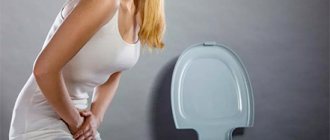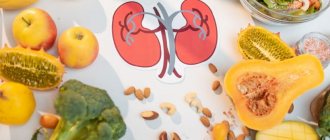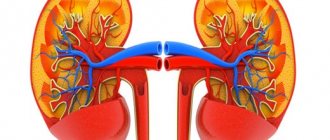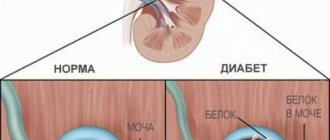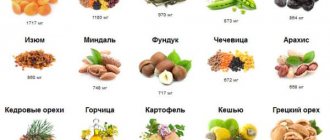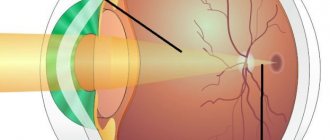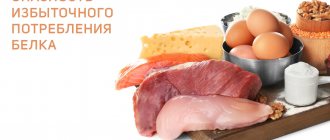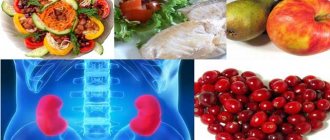In modern practical nephrology, chronic kidney disease (CKD) is distinguished. This term was proposed by the American nephrological community in 2002, and in the Russian Federation, national clinical guidelines for this pathology were prepared only in 2012. Complex treatment of CKD, in addition to medication and replacement therapy, necessarily includes a special diet.
What is CKD and how does it progress?
Chronic kidney disease (CKD) includes various pathological conditions with damage to renal tissue, which tend to have a long, progressive course with a gradual increase in the severity of renal failure.
It is diagnosed if the patient has signs of damage or decreased kidney function that persist for at least 3 months, regardless of the nosological diagnosis (for example, chronic glomerulonephritis, chronic pyelonephritis, diabetes mellitus, polycystic kidney disease, urolithiasis, arterial hypertension, systemic lupus erythematosus, etc. .). At the same time, changes in glomerular filtration rate (GFR) and data from other laboratory and instrumental methods for studying the excretory system are assessed.
The diagnosis of CKD is based on the following criteria:
- the presence of any signs of kidney damage, including changes in urine and blood tests, confirmed at an interval of at least 3 months;
- any irreversible structural changes in an organ, identified once during a lifetime morphological examination of the organ or during its visualization:
- a decrease in glomerular filtration rate (GFR) of less than 60 ml/min for 3 or more months, regardless of the presence of other signs of kidney damage.
There are several stages of CKD, the main criterion for their diagnosis is the GFR.
- There are signs of damage to the kidney tissue. In this case, GFR is normal or increased.
- A slight decrease in GFR (within 60–89 ml/min) indicates minor impairment.
- Moderate decrease in glomerular filtration rate (30–59 ml/min), this stage is often divided into stages A and B.
- GFR is significantly reduced (15–29 ml/min), severe disorders are diagnosed.
- End-stage renal failure, GFR falls below 15 ml/min. Requires renal replacement therapy.
In older people, a GFR level below 60 ml/min is considered pathological. An indicator above this is considered the age norm if the patient does not have “renal” risk factors. In this case, CKD is not diagnosed.
Nutritional therapy for kidney disease: when does it start?
The main goal of the diet for kidney disease, as well as other therapeutic measures, is to curb the rate of increase in renal failure. Therefore, certain dietary restrictions are recommended to be introduced already at stage 1 of CKD, when damage to the renal tissue is not yet accompanied by clinical and laboratory signs of functional renal failure.
Following the diet prescribed by your doctor for chronic kidney disease has several goals:
- reducing the load on nephrons working in an enhanced mode;
- partial correction of the level of nitrogenous metabolic products circulating in the blood;
- improvement of acid-base balance, mineral, lipid, carbohydrate metabolism.
The more a patient's GFR falls, the more important diet becomes. For kidney diseases at the subcompensation stage, a special diet has a supportive and preventive effect. But when signs of renal failure increase, special nutrition becomes one of the main therapeutic measures.
Diet table No. 9 and low-carb diet: comparison
Diet table No. 9 cannot boast of good results in terms of blood sugar control. In diabetic patients who adhere to this diet, glucose levels fluctuate or remain elevated all the time. A typical scenario is:
- At first, a diabetic tries to keep his sugar level, but this often results in hypoglycemia.
- Low sugar causes unpleasant symptoms and can even be deadly.
- To avoid hypoglycemia, you have to keep your sugar levels elevated “with a reserve.”
- As a result, chronic complications gradually develop in the legs, eyes, cardiovascular system and kidneys.
From the point of view of bringing sugar back to normal, only a low-carb ketogenic diet works, but a balanced diet does not. This has already been confirmed by thousands of Russian-speaking diabetics and hundreds of thousands of foreign ones. Almost no one tries to argue with this fact anymore. However, many doctors say that a low-carb diet is bad for the kidneys because it is high in protein. Many diabetics are held back from switching to a low-carb diet only by fear for their kidneys.
Read more about the products:
- Bee honey - buckwheat, white acacia, instead of sugar
- Porridge - buckwheat, rice, millet, barley and others
- Oil - butter, olive, flaxseed, coconut
- Nuts - walnuts, hazelnuts, almonds, cashews, pistachios and others
- Fruits and berries
What does a diet for kidney disease include?
The primary task of therapeutic “renal” nutrition is strict control over the quantity and quality of daily protein consumed. With an unbalanced protein diet, a variety of complications can develop. The products of their transformation in the body are toxic and sharply increase the load on the kidneys. Therefore, high dietary protein may accelerate the rate of progression of CKD. On the contrary, adequate protein intake can significantly slow the rate of development of this condition.
When drawing up a diet menu for kidney disease, the patient’s age and weight, as well as the stage of CKD, are taken into account. The required daily amount of protein is calculated individually.
A diet for the kidneys also includes limiting the intake of phosphorus, potassium and sodium, and carefully monitoring the total volume of fluid consumed. It is also necessary to monitor the total caloric content of food so that the body of a patient with chronic kidney disease receives a sufficient amount of energy.
It is impossible to create a detailed diet menu for kidney disease for several years in advance. Therefore, the most important task in the management of patients with reduced renal function is their education. A nutritionist and attending physician carry out educational work, explain the rules for preparing a diet, provide background information and give individual recommendations.
Why do you need a low-protein diet for kidney disease?
Consumption of protein products leads to a complex of hemodynamic and biochemical changes at the kidney level. With normally functioning renal tissue, this does not cause persistent and irreversible consequences. And damaged kidneys do not have the ability to compensate for such changes; as a result, their nephrons experience additional negative factors and are further destroyed.
What are the consequences of consuming enough protein?
- In the kidneys, renal blood flow increases and the ultrafiltration process intensifies, which leads to aggravation of intraglomerular hypertension. This has a damaging effect on the glomerular apparatus and may become a hemodynamic mechanism of damage to renal tissue.
- Acidosis worsens, which negatively affects the functioning of cells.
- The end products of protein glycation trigger a multi-stage biochemical cascade with the production of reactive oxygen species. They provoke the release of pro-inflammatory and profibrotic compounds, which aggravates the existing tubular atrophy and fibrosis of the renal interstitium.
Failure to comply with the prescribed protein restriction will contribute to the rapid depletion of nephron functionality and progressive nephrosclerosis.
Sweeteners
There is an opinion that artificial sweeteners are absolutely harmless and are a substitute for traditional sugar. However, it is not. According to nutritionists, only natural products can be used as sweeteners and only in strictly limited quantities. Natural sugar substitutes include honey, fructose and stevia.
Honey
Natural honey is rich in fructose, glucose and sucrose. Moreover, it does not matter what type of honey a person suffering from diabetes plans to consume. The sucrose content in this product is so insignificant (no more than 5%) that its presence in the body does not in any way affect the production of insulin. However, those who decide to include honey in their diet should know that the daily intake should not exceed 2 teaspoons.
Fructose
Insulin is not involved in the metabolism of fructose, which is why its consumption is absolutely safe for people with type 2 diabetes. Fructose has a low glycemic index, several times less calories than regular sugar and at the same time 1.5 times sweeter than sugar. No more than 40 g of fructose per day is allowed; if this rule is neglected, the liver’s sensitivity to insulin production may decrease, which can lead to negative consequences. Fructose is presented in the retail chain in the form of tablets and powder.
Stevia
WHO experts approved this perennial plant as a sugar substitute in 2004, and since then, people with type 2 diabetes have been adding stevia when cooking or in ready-made dishes. Stevia synthesizes stevioside (sweet glycoside), making its taste almost 20 times sweeter than regular sugar. According to nutritionists, stevia promotes the production of your own insulin and restores the functioning of the pancreas.
For diabetes, the daily intake of stevia is limited to 1 tablespoon per day, since its abuse can develop a toxic effect, which will lead to an increase in glucose levels. Stevia is produced in the form of syrups, powder, and liquid extracts.
Dietary nutrition at different stages of CKD
As already mentioned, the diet at pre-dialysis (1–4) stages of chronic kidney disease is low in protein, with a decrease in the consumption of foods containing large amounts of phosphorus, potassium, sodium (salt), but with sufficient calorie content. It is necessary to strictly monitor the amount of fluid consumed.
Compliance with this recommendation somewhat improves the prognosis by slowing down the rate of fibrosis of renal tissue. This is confirmed by the results of clinical studies conducted repeatedly in different countries.
In stage 1 CKD, adult patients usually do not require protein restriction; a daily protein intake of 1.0 g/kg body weight can be taken as the norm. This will account for about 13% of the total energy supply. But children with CKD should receive the full age-appropriate amount of protein per day, which will prevent them from falling behind in mental and physical development. The calorie content of the diet should not exceed 35 kcal/kg/day, the amount of liquid consumed should not exceed 2 l/day. Sodium intake is limited to 2.4 g/day. Restrictions on potassium intake (its content in the diet is 4 g/day or more) and phosphorus are not required. When preparing a diet, preference should be given to vegetable fats and complex carbohydrates.
In stage 2 of chronic kidney disease, protein intake is usually somewhat limited (not lower than 0.8 g/kg/day). The diet includes regular foods. About 60% of the protein should be proteins of high biological value (meat, fish, soy protein, egg protein). The energy value of the diet is 35 kcal/kg/day (55% carbohydrates, 35% fats). Polyunsaturated fats and complex carbohydrates have an advantage; foods high in cholesterol are limited. The intake of sodium, water, phosphorus and potassium is the same as in the first stage of CKD.
The diet for CKD stages 3-4 is adjusted so that the daily protein intake averages 0.6 g/kg of recommended body weight. More stringent restrictions are irrational and can lead to a deterioration in the condition of a person with CKD and the possible development of malnutrition (MN). Diets with a more severe protein restriction are recommended for short courses (about a month) only in patients who are not able to undergo dialysis treatment in the near future. Such approaches to therapeutic nutrition partially relieve the symptoms of uremia (nausea, vomiting, itching, etc.). In order not to reduce the calorie content of the diet (at least 30 kcal/kg/day), it is recommended to increase the amount of vegetable fats and carbohydrates (both complex and refined) in the diet.
At these stages, efforts are also aimed at identifying and treating complications, mainly arterial hypertension. Along with mandatory drug therapy, sodium intake is more strictly limited (2.3-2.4 g/day) and fluid intake to 2 l/day with preserved diuresis. In some cases (for example, with malignant arterial hypertension), the doctor recommends completely eliminating table salt from the diet. When diuresis (oliguria) decreases, it is recommended to consume 400-500 ml more fluid per day (including liquid food) than excreted in urine the day before. If you sweat profusely, your doctor may order more fluids. It is not advisable to adjust your drinking regime without permission.
Potassium consumption is reduced to 2-4 g/day and phosphorus to 0.8-1.0 g/day.
During the pre-dialysis diet for kidney disease, preference is usually given to protein products of animal origin, since they contain essential amino acids. It is also recommended to replace part of the protein supplied with food with keto analogues of essential acids; most often, for this purpose, soybean protein isolate is introduced into the menu or the drug “Ketosteril” is prescribed). This can significantly reduce the nitrogen load on the kidneys and reduce the amount of phosphorus intake.
In stage 5 of chronic kidney disease, when renal replacement therapy (RRT) has not yet been started, restricting protein in the diet in the sense of nephroprotection no longer gives anything. Nevertheless, it is necessary to limit dietary protein in order to reduce uremic manifestations that are difficult to tolerate by patients (nausea, vomiting, thirst, etc.). In addition, many patients themselves reduce their food intake due to a sharp decrease in appetite (even anorexia) in the terminal stage of renal failure. However, until dialysis treatment is started, in the fifth stage of CKD it is necessary to strictly ensure that patients consume a minimum of potassium, sodium, phosphorus and fluids.
However, no dietary or drug treatment in stage 5 CKD can provide any significant and lasting effect. The only way to save a life is to start renal replacement therapy as quickly as possible.
With the start of renal replacement therapy, recommendations are revised, and the amount of protein consumed during the dialysis phase increases. The consumption of potassium, phosphorus, sodium and fluid is also adjusted depending on the patient’s condition and his clinical and laboratory parameters.
Authorized Products
During the diet, dishes are prepared without adding salt or with a minimum amount of it. Allowed products:
- vegetable soups,
- fruits and vegetables,
- lean meat and fish,
- low-fat dairy products, except hard cheeses,
- rice and buckwheat porridge,
- whole wheat bread,
- eggs up to 2 times a week,
- vegetable oils,
- compotes, infusions and herbal teas.

